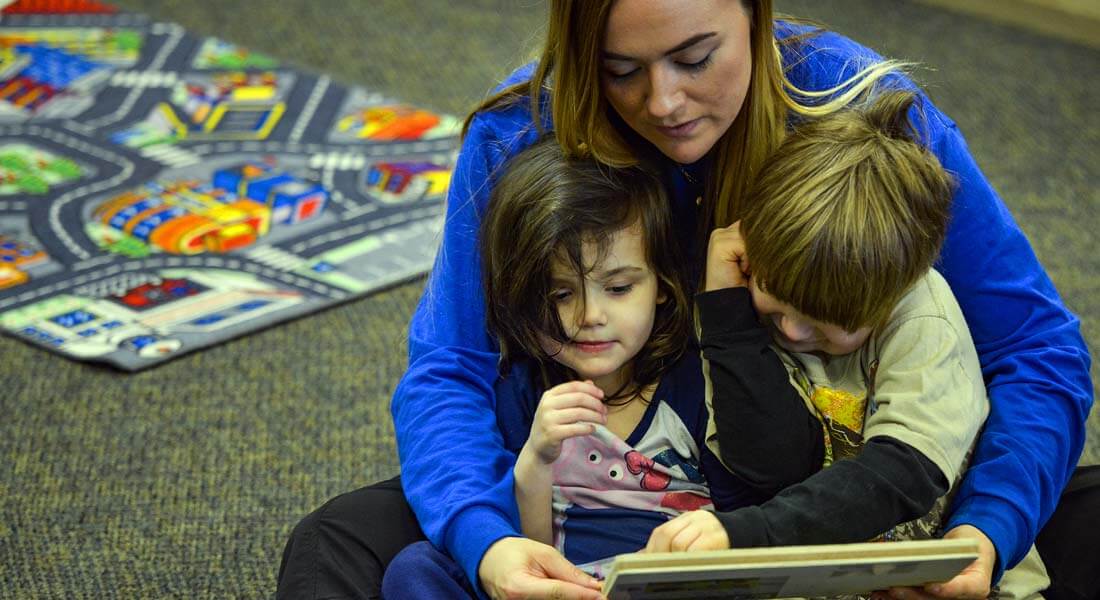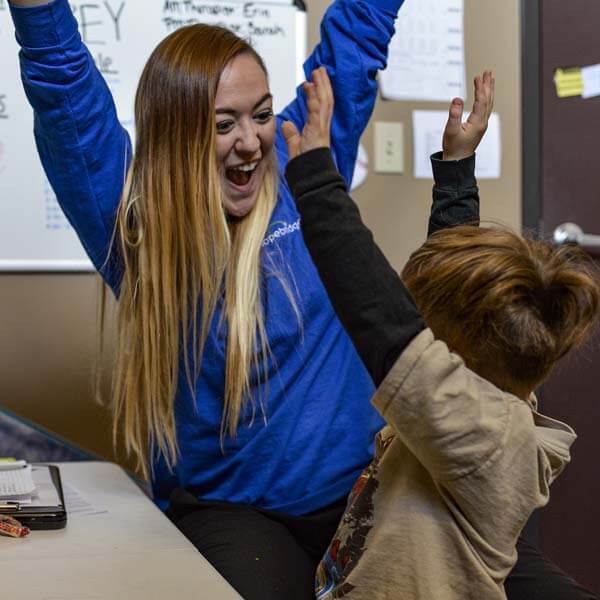What is Natural Environment Teaching? Learn from a Hopebridge BCBA Series
June 15, 2018
June 15, 2018

As a caregiver of a child with autism taking part in applied behavior analysis (ABA) for the first time, there is as much for you to learn as there is for them. You might be overwhelmed with what feels like never-ending questions. One of these thoughts might be, “Why are they just playing … shouldn’t the clinicians do more than sit on the floor with him?” If this is on your mind, you might be witnessing Natural Environment Training (NET).
NET plays an important role in ABA therapy programs, but it can be difficult to understand at first. To help explain what it is all about and why it is significant in your child’s life, Hopebridge Board Certified Behavior Analyst (BCBA) Sara Sheffler gives us the scoop as part of this blog’s “Learn from a BCBA” education series.
Sometimes referred to as naturalistic teaching, NET is an evidence-based teaching method in which ongoing learning exercises take place in an individual’s natural settings. This means it can occur anywhere – in a therapy room, home, church, Target, you name it (or rather, your child does!). Through NET, we implement teaching opportunities while kids are playing and engaging in their regular activities.
Natural Environment Teaching plays a role in a range of goal targets, such as cognitive, social, language, play or motor skills. It can be used to model, shape and train behaviors, as well as build upon an individual’s available positive reinforcement options.
Like other areas of ABA therapy, good candidates include anyone and everyone. NET happens all the time; you probably don’t realize it’s happening. It occurs in the workplace, on a sports field and within a budding romantic relationship. As part of autism therapy, the ideal candidates receive it as part of early childhood intervention between the ages of 1 and 3 years old, since it is effective in building the foundation for language acquisition and social skills.
The techniques are strategically designed to function when the child is actively engaged. Research shows that when children are engaged as active participants, learning is more meaningful and generalized quicker. It helps them create and connect new experiences and gain knowledge because their initiation and spontaneity are fostered and rewarded.
We use NET a lot when therapists initially “pair” with kids. This is the portion that can sometimes be confusing for families because it looks like we are just playing, but we are actually using these moments to make them more comfortable and incorporate little teaching opportunities. It kind of happens on its own, out of the blue, but that does not mean we’re not strategic about it.
For example, let’s say there is a girl who has autism spectrum disorder (ASD), is verbal and just beginning therapy at Hopebridge. if I were the therapist, I begin by pairing with the child in order to build rapport. The first day I work with her, she gets free rein of the session and we do what she wants. The next day, she chooses to play with cars. I follow her lead and grab one of the cars, but I make mine sound way more fun so she will try to take it from me … the catch is, I may not give it up until she says “car.” Once she says it, I give it to her and offer her tons of praise. She received great attention from me, which makes me reinforcing to her. The instructional control begins to shift towards my favor.
This practice gets the child engaged where we as the therapists become reinforcing because we’re doing things they already enjoy. Kids don’t realize we’re engaging them through prompts.

A part of NET teaching is driven by the child and his or her initiation.
To continue to build social skills, which are important to many families, other scenarios could include children playing in a gross motor gym. A boy might want a ball but is unable to vocalize his desire, so we teach him how to tap the other child on the shoulder as a way to ask him to share.
NET is one piece of a larger therapeutic program. When we combine it with other methods, we can effectively increase the skillset in as many environments as possible to increase generalization. We can attempt to teach these skills in a one-on-one setting all day long, but unless they get put these skills into action with peers, they are often not effective. NET settings give more meaning to language and social skills.
The benefits of NET are vast. Beyond its proven effectiveness – which we see nearly every day at Hopebridge – there are other reasons to use it.
Naturalistic teaching is driven by the child and his or her initiation, and then spontaneity is rewarded to promote the child’s contribution to learning. It’s individualistic, enabling therapists and caregivers to create learning experiences that are specifically designed to help the learner connect to new things with existing knowledge. Kids are accustomed to trying to get our attention, but through NET, we’re able to have them work on it in a new way.
Another advantage is that it reduces dependence on prompts from therapists. It is also active in scenarios with distractions; better preparing them for interactions in the outside world.

NET is family-friendly and can be used by parents, grandparents, siblings and other loved ones.
But the biggest benefit of all? NET is family-friendly. It can be used by parents, grandparents, siblings and other loved ones. To get a family on board, Hopebridge offers family guidance, which includes coverage of NET. Once they understand the principles and how it’s connected to their world, we talk about how to incorporate it at home. They quickly realize it is an easy strategy that can be used anywhere and everywhere. In addition to teaching parents in person, we also provide resources to inform other family members, such as videos, articles and step-by-step task analyses.
When families extend the practice of NET outside the center, it tends to increase the quantity and quality of learning experiences. From meal time to bath time to trips into the community, each exposure helps your child learn to use his or her skills in new ways. Here are a few quick tips:
NET occurs every day at Hopebridge, but there are certain encounters that stick out in my mind.
I worked with a kiddo who didn’t engage much with peers. We found out he likes “Sesame Street,” so another BCBA played with a toy associated with it, which captured his interest. Suddenly, he tapped the therapist’s shoulder for attention. We all reacted very positively. Next thing we know, he says, “Sesame Street!” We continued to play with it; labeling the different characters. The boy repeated all of them to us. We started dancing, then he started dancing.
Not only were we able to work on verbal responses, but we had real engagement. This was so exciting because it was limited until that point. This is the power of NET used correctly.
If you’re interested in learning more about naturalistic teaching and other ABA strategies that can make an impact on your child’s life, get in touch with us online to find a Hopebridge center near you.
*Informed consent was obtained from the participants in this article. This information should not be captured and reused without express permission from Hopebridge, LLC. Testimonials are solicited as part of an open casting call process for testimonials from former client caregivers. Hopebridge does not permit clinical employees to solicit or use testimonials about therapeutic services received from current clients (Ethics Code for Behavior Analysts 5.07-5.08; BACB, 2020). Hopebridge does not provide any incentives, compensation, or renumeration for testimonials provided by a former client or client caregiver.
Autism Therapy
September 05, 2025
Hopebridge Continues to Grow Autism Therapy Services in Founding State of Indiana
Autism Therapy
November 29, 2022
Hopebridge's TJ Larum Bridges Gaps in Access to Autism Care with Global Autism Project
Autism Therapy
October 21, 2020
RBT Study Guide: The Best Resources to Become a Registered Behavior Technician